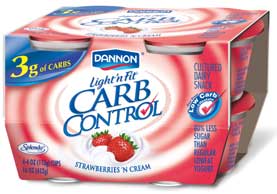
It's almost impossible to not be aware of the trend in controlling carbohydrate intake, which is better known as low-carb dieting. In fact, a recent survey of 1,100 people indicated that more Americans know about low-carb diets than any other formal eating plan. The study, which was conducted by Cincinnati-based Valen Group, showed that about 84% of respondents recognized low-carb diets, versus 81% who said they were familiar with Weight Watchers.
The study was conducted in conjunction with Denver-based LowCarbiz newsletter, which held a two-day summit this past week. The summit attracted representatives from leading U.S. food companies, all interested in how they can profit from the estimated $15 billion (and growing) low-carb business.
This study also found that 59 million Americans are watching their carb intake, not necessarily to lose weight, just manage it better. It's such a hot food trend that over the weekend the Chicago area experienced the opening of its first store dedicated exclusively to selling products for people following a low-carb lifestyle. Low Carb Chicago Inc., Vernon Hills, Ill., joins the more than 200 low-carb specialty stores that have opened in the past two years, primarily on the West Coast.
"The low-carb lifestyle is not a passing fad but represents the start of a fundamental shift in the eating habits of Americans," says Kent Roberts, founder of Low Carb Chicago.

What exactly are net carbs, and how do they differ from carbohydrates in general? The term net carbs, though not legally defined, refers to the total amount of carbohydrate that negatively affects (i.e., increase) blood sugar and insulin. These are the carbs that low-carb dieters avoid. Such carbs are referred to as high-glycemic, with net carbs calculated by subtracting low-glycemic carbs (which includes fiber and sugar alcohol) from total carb content. Glycemic index is a ranking of carbohydrates on a scale from 0 to 100, depending on how much the carbohydrate raises blood sugar levels after eating. Foods with a high-glycemic index are rapidly digested and absorbed and result in big fluctuations in blood sugar levels. But foods with a low-glycemic index, by virtue of their slow digestion and absorption produce gradual rises in blood sugar and insulin levels.

Dairy's part in low-carb lifestyles
Though restricted by some, but not all branded low-carb diets during the early weeks of dieting, natural cheese, which is virtually free of carbs, is an important part of such diets, as cheese provides calcium and protein.Kraft Foods Inc., Northfield, Ill., recently ran an ad showcasing its extensive line of natural cheeses with the tagline: As always, all these Kraft cheeses have 1 gram or less of carbohydrates per serving. So you can count on great taste while you are counting carbs.
Other dairy products need some reformulation to qualify for the unofficial descriptor of "being part of a low-carb lifestyle." For example, The Dannon Co., Tarrytown, N.Y., just rolled out Light 'n Fit Carb Control, the first nationally available cultured dairy snack with fewer net carbs than regular yogurt.
The ice cream category has experienced the most rollouts of product for low-carb diets. Right after the New Year, Byrne Dairy, Syracuse, N.Y., introduced CarbSense. "We challenged ourselves to come up with a low-carb ice cream that is only 3g net carbs per serving, and still tastes great. The flavor profile of CarbSense will surpass your expectations," says Dave Prendergast, ice cream brand mgr.
Good Humor-Breyers Ice Cream, Green Bay, Wis., just added a Klondike ice cream sandwich to its line of CarbSmart frozen desserts.
Ice cream products, in particular, are a great way for low-carb dieters to satisfy their sweet tooth without cheating on carb intake. With more than 65% percent of the U.S. population described as overweight or obese, low-carb diets are one of many dieting approaches to lose weight and no longer be part of the statistic. Dairy manufacturers can help by formulating carbs out, making the perfect source of calcium available to all consumers.
